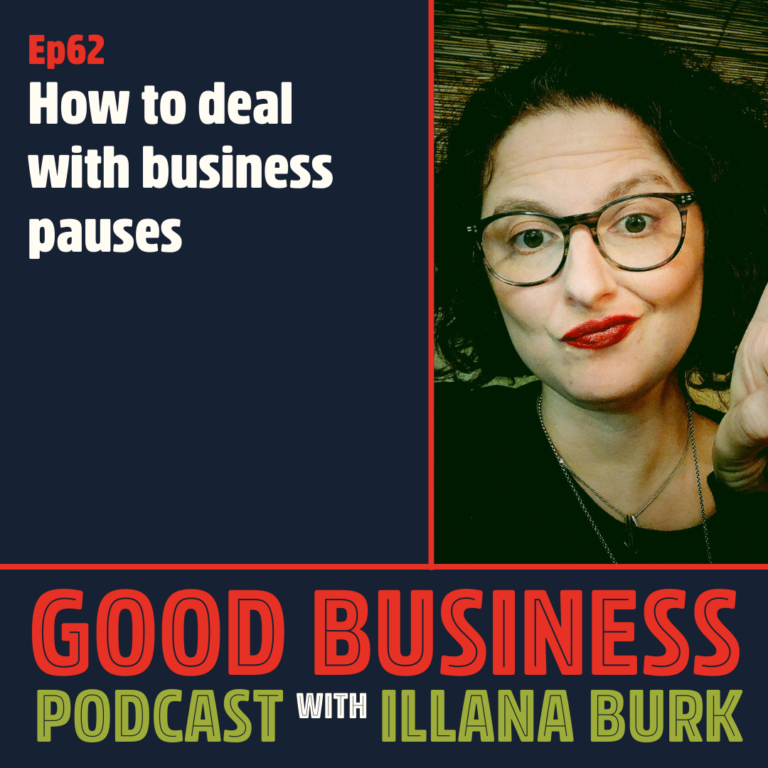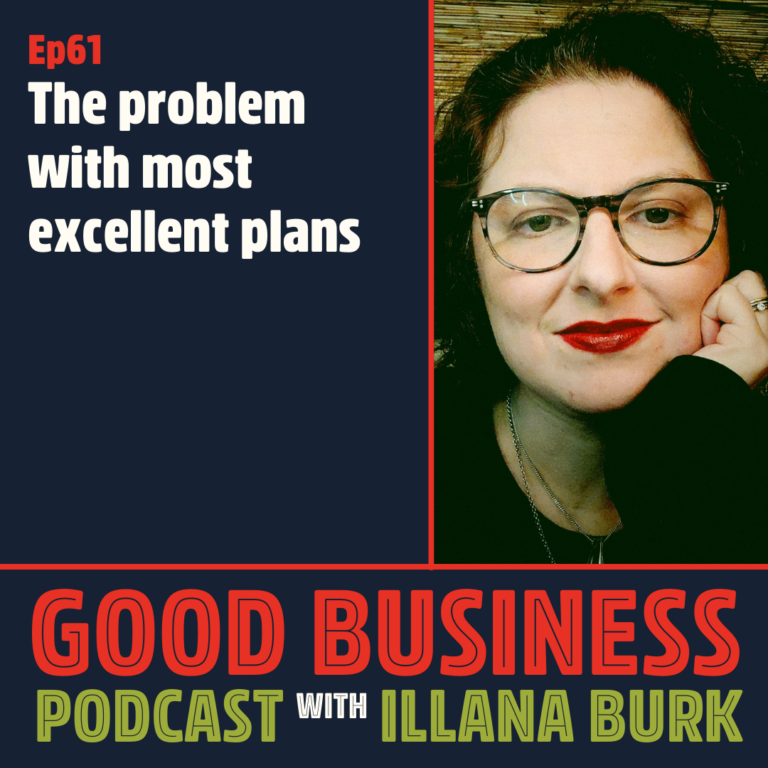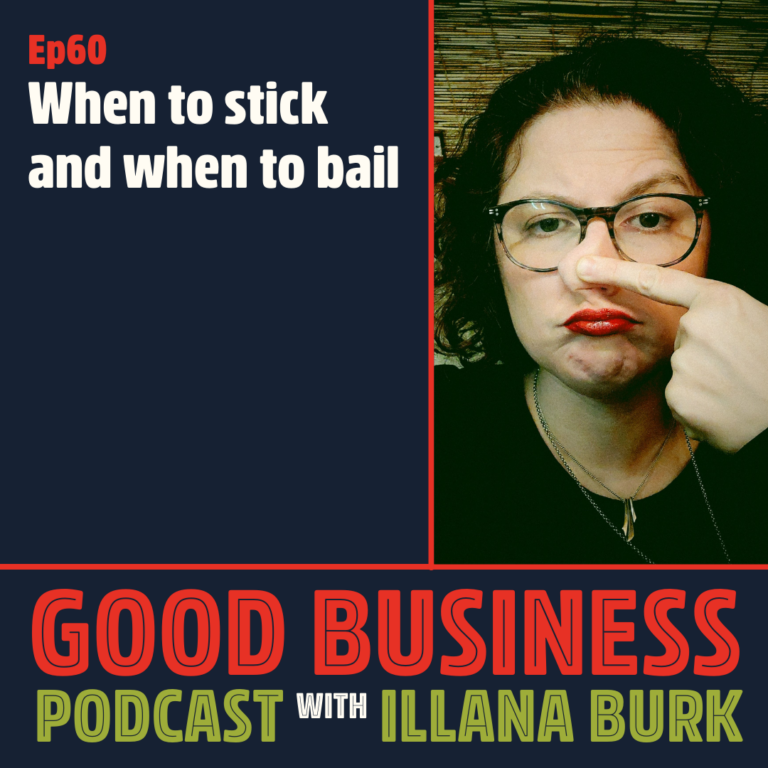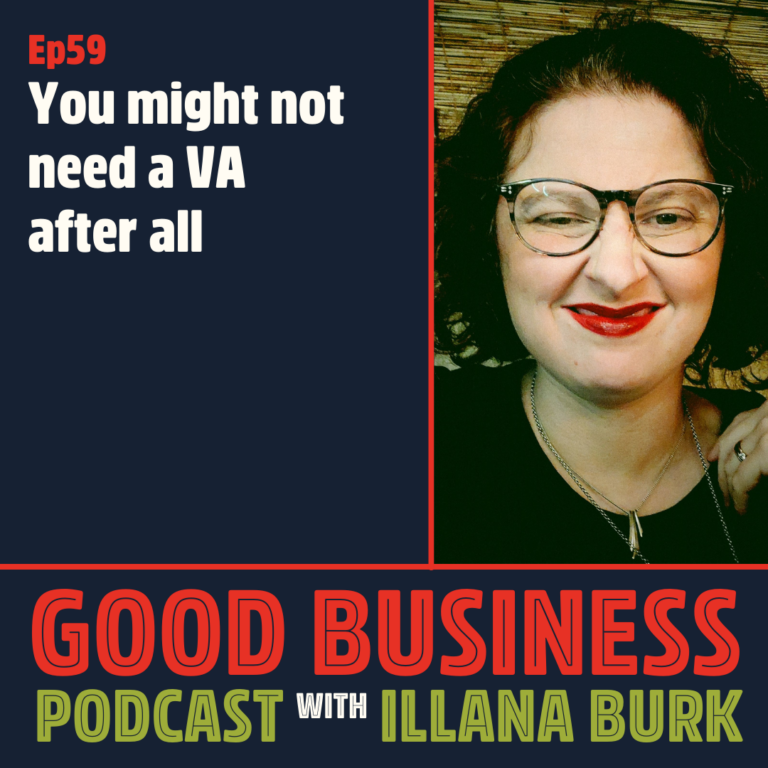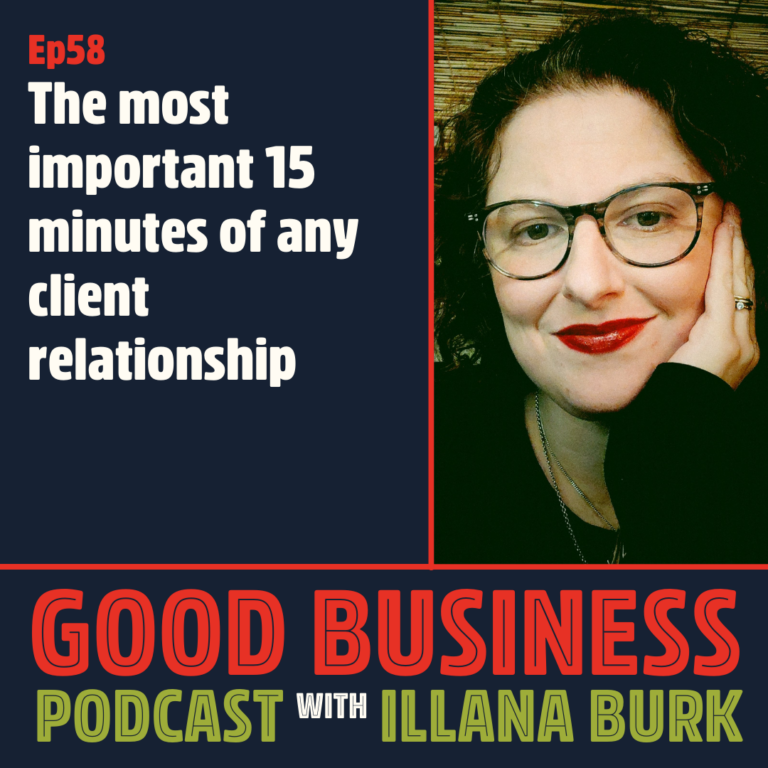Today’s episode is about constraint. That’s right. Constraint and scarcity and false scarcity. Ready?
Episode Transcript:
Hi everybody. And welcome back to The Good Business Podcast. I’m your host, Illana Burk. I am delighted to have you here today. And today I’m going to talk about a really tight little lesson. We’re going to talk about constraint and the power of constraint.
Now, constraint is not the same thing as scarcity. And that’s something that, that’s the first part of what I want to talk about is that. A lot of people use these concepts as interchangeable. And today we’re going to dig into the difference between constraint and scarcity and false scarcity and how those three things affect users, buyers, consumers differently, no matter what you do.
So. The first thing I’m going to talk about, I’m going to kind of define what each of those things are. Then I’m going to dig into how to think about constraint in your own business and your own work. And then, I’m going to give you a little bit of, information about how I deploy constraint in my own business and what that means to me. First, we’re going to define these three ideas, constraint, scarcity, false scarcity. and what they are and what they’re not because they get tossed around, especially in kind of ethical circles, a lot of like what these things are and they start to kind of lose meaning.
So first of all, for this context, what we’re, when we talk about constraint, we’re actually talking about like putting limits on your reach, putting limits on your ability to grow, putting limits on your scalability. Putting limits on your creativity as a way of tightening the edges and making things more integral, more creatively deep, a deeper well, one could say right. That those are, that’s the way that I generally deploy constraints. So we’ll talk a little bit more about that in a bit, but that’s the baseline.
Now scarcity is when you have a finite amount of something. Actual scarcity is a thing, right? If you have four chairs to teach four people a lesson, then you can only take four people, or you have standing room only, which is gonna lower the value point, right? Now online, it’s real hard to actually create, you know, to actually have real scarcity because chances are good that like an infinite number of people could fit in a Zoom call.
So, it’s harder to create scarcity.
Now, scarcity creates a thing in people’s brains. Now, when we think about this through the marketing lens, the reason why we hear so much about scarcity is because scarcity creates buying decisions. When people know there’s only one of something left, they immediately want it more. When it’s the last piece of pizza, even though you’re full, you really kind of want that last piece of pizza. We are humans who feel like there’s a survival element to this, right? Where if it’s the last of something or there’s very few of something, our survival instinct kicks in where I must gather that thing in order to survive whatever’s next.
Our brains, however, this is a lizard brain response, which is why marketers love it so much. Because it short-circuits higher reasoning. Because when you actually deploy higher reasoning, actually, dude, you’re full. You don’t need that piece of pizza. Or, Hey, your marketing is fine. You probably don’t need to spend two grand on that marketing course that they said is, you know, time is running out and there’s only four spots left.
That’s false scarcity. So we’re kind of talking about these things simultaneously a little bit here. But real scarcity is where there’s like a legitimate constraint put on something that is for a reason that you can articulate. Meaning, let’s say you’re going to do an online course for something, but it comes with a handmade art piece or a box of cool objects that are going to enhance the learning experience in some way that are going to be mailed to people’s houses.
And you only have 10 of them. There’s real constraint there. You cannot take any more than 10. There’s real scarcity there. You’ve constrained the experience because you can see from a leadership perspective that having only 10 people is going to deepen people’s connection with the work itself. You can see that having more than that would actually dilute people’s ability to connect with one another. Right. That’s how you’ve designed something that the constraint creates scarcity. So that’s real legitimate scarcity. And then going into the marketing path of like how you develop all of your content, then you can make decisions around that based on the realities, instead of something false that’s designed to trigger a buying decision. If you’re looking at it to trigger a buying decision, then you’re putting the emphasis in the wrong place, just inherently.
You’re doing it wrong if you’re trying to just get people to buy. The idea is to create something that has value to the right people. Now that’s a lot harder. False scarcity is a lot easier.
Now let’s talk about what false scarcity is. False scarcity is things like we only have 12 copies of a digital product. I mean, fucking come on seriously. Like you really expect people to believe that.
Well, they might not believe it, but it’s still gonna activate the money. and you’re not immune. I don’t care who you are. I don’t care how rebellious you are. I don’t care how critical you are. We are absolutely animals underneath it all. I am just as guilty as anybody else. I have fallen into marketing funnels and found myself thinking,
Huh, maybe I do need that thing, watching some video of some dumb bro marketer selling something that I absolutely do not need and will have absolutely no value to me whatsoever. But there are psychological triggers that they are pulling on that you are not physiologically capable of rejecting outright. Your brain will react to what’s being said, even if you’re trying to be skeptical. Now, I’ve never actually clicked by mostly because I’m really cheap, but I’ve certainly found myself going. I can’t even believe, like my higher reasoning starts kicking in. I’m like, I can’t even believe that I’m even interested in this. This is so stupid. But then I’m like going, okay. Hey, there’s a bunch of color theory here. There’s red buy now buttons. There’s flashing lights. There’s a countdown timer. There’s all this stuff. Basically tricking my brain into thinking I’m being chased by a tiger.
And the only way out is to click buy now. There is actual chemical things happening in your brain when false scarcity is deployed. This is why that shit’s super unethical and super shitty. And why I rail against it all the time because you are triggering people into buying, not creating something valuable enough that they want to buy it.
Very often when you see people deploying false scarcity, in this way, what you will also see on the flip side, in their launch analysis and stuff like that is that they’ll, they’ll say things like they have, you know, 20 to 30% attrition or, you know, pretty significant drop-off and refund rates or they have things like they just don’t offer refunds, or they say it’s a hundred percent money-back guarantee if you complete all of the coursework and can prove it and jump through these nine hoops and then we’ll maybe consider that after you feel totally ashamed that you didn’t do all the work and now you have somebody wagging their finger at you and all the things. We’ve all seen this stuff.
What I want to talk about though, is like, what happens when you create something that has real constraint to it, and there’s real reason behind it. And you can articulate those things. And they’re well-aligned with the value proposition that you’re putting out there. Now that has real power because now, yes, you’re still hitting that little like fight or flight survival thing going on because there’s real constraint, but when there’s real value mixed with real constraint, that’s gold. That’s viral content. That’s content that sings. Now it’s harder to do though. That’s the thing. It’s really hard to do because it requires a level of depth and a mastery that most content providers simply don’t possess. They just don’t. and the more scarcity I see put on things, the more I assume there is less value to be had.
So when I see all the tricks deployed, the more tricks, the less value as far as I’m concerned. And I’ve yet to be proven wrong. If somebody has an example of someone who deploys all of those tactical nonsense, crap, scarcity, all the things. And then they were like, Yeah, and it was so worth it. And I learned so much.
Please reach out. I would love an example of being wrong on this, but in 13 years I haven’t seen one yet. But when I see somebody who’s like, Hey, I’m going to do this thing. Here’s all of my experience. I only have 10 seats. I wish I had more, but I don’t because here’s why, here’s why this is the right thing.
Then, what I get is something that’s extremely high value. Now, for example, here’s the constraint that I’m placing in my business. I have constraint points in it in a few different ways. The first is on one-on-one work. I take two calls a day, four days a week. No more. That means that I have legitimate constraint on my time. I cannot perform at my highest level and do any more calls than that. That’s it. That’s all there is. There is no more.
That means that I can take a total of what’s the math on that, like 32 calls a month. Maximum. That’s if I never want to take a break. Which I don’t, I don’t take a lot of vacations because I have a really manageable, balanced schedule. So that’s okay with me. That’s how my life works. That means that I get to be off at three o’clock every day to hang out with my kid while she’s still little and cute and wants to hang out with me. So these are the things that matter in my world. And that’s the real constraint that’s at play.
Now, what that means is after 13 years, I could charge a lot more than I do because I have legitimate scarcity on my time. And I’m usually running with the waiting list. Now, this is where the ethical choice comes in of how much do I want to charge to make it meaningful. Right. How much do I want to charge knowing that that’s the constraint? Well, for me, I work backward from what a solid living, based on how much time I’m spending looks like. And that, and that’s how I set my rates. My rates are. They just went up for the first time in like seven years.
And they are still manageable. I aspire always to be manageable so that I can pick and choose the clients that I want to work with, because that feels sustainable for me. Now, your version of sustainable might look like something entirely different. Your version of constraint might look like something entirely different, but your timing capacity is absolutely a constraint that you may or may not have discovered where that is yet, like how much time you can spend doing whatever it is you do. But I encourage you to explore it and figure out what your actual constraints are. Because what happens, especially among creatives and service providers, you don’t really know what your constraint is, you don’t really know what your capacity is at any given time, because you’re taking things on a, you know, it’s like the difference between a push or a pull, right. When a client is pushing work at you and then you’re reacting to it, you don’t know how long it’s going to take. You don’t know how much capacity it’s going to gobble up and you don’t know what kind of constraint you actually have. So you can’t really set an accurate price tag for something that you haven’t experienced yet. It’s one of the most difficult parts about being a service provider. So then you don’t have boundaries either, right?
So you forget to set like time constraints on your day in your life. And that becomes harder and harder to hold the less and less you do it. So now you not only have constraint on your time, you have a lack of constraint on your energy, because now you’ve taken work at a rate that you couldn’t afford to take it and you don’t know how long it’s going to take. And now you’re in a mess. And now you undercharged or you overcharged or, you know, there’s no alignment there.
So, you can understand finding your sense of time-based constraint is a really, really good place to start. Now you have at least a sense of like, as a service provider, at least what your, your framework capacity can look like now. For me, another way of looking at this in another example is, in courses and groups and things like that. I know that a lot of people listening are going to be doing stuff like that, or are currently.
I run a community, the Your Life’s Workshop. The workshop space is awesome. It is. Relatively small. I think we have around 70, 75 members right now. mostly because I’ve done almost nothing to market it. But that’s changing. Because I really wanted it to find its legs first. I wanted to figure out what it needs to be. One of my favorite, very favorite quotes is from Gary Erickson, the CEO of Clif Bar that he said, “If you listen closely, your customers will tell you who you are.” It’s something that I’ve had up on my wall in my office forever.
So I take my time with things. When I launched the community, we’re about six months in, and now I’m starting to understand what they need. Well, what that means to me is that I’ve put a cap on it. My constraint is that the community will never increase past 250 people. Based on average usability, how people sort of ebb and flow, how many people show up for calls, what feels manageable for people to still get the same high touch experience, and for me to keep the baselines of promises that I’ve made for interactivity, for feedback, for how much I can reasonably show up in one space and create both comradery and mentorship and leadership and get people what they need and still be able to be responsive to change. 250 seems like a good cap that, that feels like a manageable amount of people that I can’t go over. If I do decide that I want more groups or larger groups, I’ll split it off and I’ll do something else. But this group will never have more than 250 people in it.
So if you want to be one of them, you know, consider that because it’s a cap, I’m publishing it. I’m saying it publicly. It’s something I’ve told everyone there, which made them feel really valued. And that matters right. Showing that my people that I’m not going to just continue to grow that I’m not going to just continue to solicit and market and increase numbers and numbers and numbers and numbers and numbers to make more and more and more money. That’s telling them that I value their experience more than I value making more and more and more money.
Now I may never get to 250 people. That might be like, it’s not really a goal. It’s a cap. Like I might not get there and I’m okay with that too. But knowing that they’re in a space that they’re never going to get lost in, it’s never going to be 10,000 people. It’s never, no matter what happens in my business, no matter how much I decide to market, that’s not something that will happen based on the promise that I’m making to my people to create the very intimate, deep-diving space that they signed up for. That’s my promise to them.
So my constraint is born out of effective promise-keeping. So when you think about the constraints that you are putting in place in your own business, think of it through that lens.
What are the promises that you’re making what are the conditions you need in order to keep those promises somewhere in that equation is your level of constraint. But you got to know what it is, or you’ll continue to exceed capacity and make promises that you can’t keep.
More Episodes
How to ask for and take feedback | GB63
Navigating feedback can be daunting. In this episode, we dive into the skills of asking for and receiving feedback with intention and grace. Learn the art of crafting your asks to elicit constructive insights and how to...
How to deal with business pauses | GB62
In the fast-paced world of entrepreneurship, taking a break can often feel like a foreign concept. The constant pressure to grow, scale, and make a bigger impact can make prioritizing personal well-being and life outside of work...
The problem with most excellent plans | GB61
Ever plan an amazing business move but hit a roadblock? This episode tackles the "pothole" of poor planning for solopreneurs. Learn how to "right-size" your strategy based on your resources and set yourself up for sustainable...
When to stick and when to bail | GB60
Feeling stuck in a business project that’s not taking off? This episode’s for you! We explore the often-overlooked skill of quitting and guide you through 4 key questions to help you decide when to persevere or let go. Learn to identify your true motivations, navigate self-doubt, and make choices that align with your goals and well-being. Listen to discover when to stick and when to bail!
You might not need a VA after all | GB59
Overwhelmed business owner? Stop! Hiring a VA might not be the answer. Learn how to ID expert vs. VA tasks & hire the right person for the job (without becoming a “shitty boss”). Listen in and get bonus tips in the show notes!
The most important 15 minutes of any client relationship | GB58
In this episode of the Good Business Podcast, we dive into the critical 15 minutes that can make or break a client relationship. Want to know why these first few minutes are so crucial, what should be included, and how to adjust...
